Papers by Kai Daniel Schmid
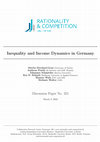
SSRN Electronic Journal, 2022
We provide a comprehensive analysis of income inequality and income dynamics for Germany over the... more We provide a comprehensive analysis of income inequality and income dynamics for Germany over the last two decades. Combining personal income tax and social security data allows us-for the first time-to offer a complete picture of the distribution of annual earnings in Germany. We find that cross-sectional inequality rose until 2009 for men and women. After the Great Recession inequality continued to rise at a slower rate for men and fell slightly for women due to compression at the lower tail. We further document substantial gender differences in average earnings and inequality over the life-cycle. While for men earnings rise and inequality falls as they grow older, many women reduce working hours when starting a family such that average earnings fall and inequality increases. Men's earnings changes are on average smaller than women's but are substantially more affected by the business cycle. During the Great Recession, men's earnings losses become magnified and gains are attenuated. Apart from recession years, earnings changes are significantly right-skewed reflecting the good overall state of the German labor market and increasing labor supply. In the second part of the paper, we study the distribution of total income including incomes of self-employed, business owners, and landlords. We find that total inequality increased significantly more than earnings inequality. Regarding income dynamics, entrepreneurs' income changes are more dispersed, less skewed, less leptokurtic and less dependent on average past income than workers' income changes. Finally, we find that top income earners have become less likely to fall out of the top 1 and 0.1 percent.
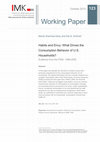
In this paper we estimate the relevance of habits versus inter-personal comparisons for the consu... more In this paper we estimate the relevance of habits versus inter-personal comparisons for the consumption behavior of U.S. households. We exploit information from the recently released consumption expenditure data of the Panel Study of Income Dynamics (PSID) covering the time span from 1999 to 2009. We find that both habits, measured as lagged consumption, and envy motives, measured as reactions of consumption to consumption changes of households that are perceived to be richer, matter substantially. Hence, household consumption is not only determined by habit persistence but also by interpersonal comparisons. Most importantly , our estimations reveal that envy motives might play a much more prominent role for households' consumption choices than habits do. JEL ref.: C23, D12, D91, E21. Abstract In this paper we estimate the relevance of habits versus interpersonal comparisons for the consumption behavior of U.S. households. We exploit information from the recently released consum...
außeruniversitäres Forschungsinstitut, das am 17. Juli 1957 auf Initiative von Professor Dr. Hans... more außeruniversitäres Forschungsinstitut, das am 17. Juli 1957 auf Initiative von Professor Dr. Hans Peter gegründet wurde. Es hat die Aufgabe, Forschungsergebnisse aus dem Gebiet der Wirtschafts- und Sozialwissenschaften auf Fragen der Wirtschaft anzuwenden. Die Tätigkeit des Instituts konzentriert sich auf empirische Wirtschaftsforschung und
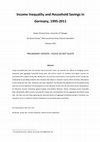
Using household data from the German Socio-economic Panel, we examine the effects of changing inc... more Using household data from the German Socio-economic Panel, we examine the effects of changing income inequality upon aggregate household saving rates. We confirm recent U.S. evidence that higher incomes are associated with a higher saving rate. Besides this, we show the causal nature of this positive income saving rate relationship by providing evidence that increases (decreases) in absolute income induce increases (decreases) in the saving rate over time. Moreover and most important, we illustrate that adjustments of household saving rates do not only depend on the development of own absolute income, but are also driven by the development of reference incomes indicating upward looking consumption behavior. Hence, changing income inequality does substantially affect income class-specific saving rates and therefore also the aggregate household saving rate. This does not only help explaining the observed decline of aggregate household savings in Germany, but also gives rise to a numbe...
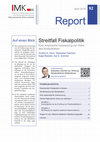
Can discretionary fiscal policy stabilise the business cycle? This crucially depends on how fisca... more Can discretionary fiscal policy stabilise the business cycle? This crucially depends on how fiscal impulses pass through the economy.A systematic meta-regression analysis of 104 studies covering 1069 estimations of the fiscal multiplier allows a comparison of the effects of different fiscal policy actions. The analysis explains differences between reported values of the fiscal multiplier with reference to several control factors and suggests a number of straightforward implications:Discretionary fiscal policy is fundamentally an appropriate way to stabilise a stagnating or booming economy. Discretionary fiscal policy should therefore be reconsidered as part of the standard macroeconomic policy mix.The size of the effects of fiscal policy depends on the respective policy action. Contrary to the recommendations frequently made in the financial crisis, fiscal stimulus should particularly comprise expenditure packages as these actions exhibit significantly stronger effects than measures...
Auf einen Blick Gängige Verteilungsanalysen unterschätzen das Niveau der Einkommensungleichheit i... more Auf einen Blick Gängige Verteilungsanalysen unterschätzen das Niveau der Einkommensungleichheit in Deutschland aufgrund der Untererfassung von Spitzeneinkommen in Umfragedaten. Neuere Studien zeigen auf, dass dies auch zu erheblichen Fehleinschätzungen über die Entwicklung der Ungleichheit führt. Inhaltsverzeichnis Ungleichheit als Megatrend in der aktuellen Forschung 2 Verteilungsdiskussion in Deutschland 2 Querverteilung als blinder Fleck in der Verteilungsforschung 3 Kapitaleinkommen und Konjunktur im SOEP 3
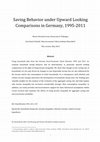
Using household data from the German Socio-Economic Panel between 1995 and 2011 we examine househ... more Using household data from the German Socio-Economic Panel between 1995 and 2011 we examine household saving behavior and its determinants, in particular upward looking comparisons in the light of rising income inequality. We show that changes in the saving rate of households are not only driven by changes in own disposable income but are also influenced by the income and/or the consumption of richer households. As a consequence, both absolute and relative income changes determine the development of household saving rates. Our findings give valuable insights for the analysis of the evolution of the aggregate saving rate and help explain why income inequality has increased considerably stronger than consumption inequality. In addition, our study provides microeconometric support for basic behavioral assumptions within recent research that examines the effects of rising income inequality for aggregate saving and macroeconomic instability. JEL-Classification: D91, E21, C23
Using data for Germany from the German Socio-Economic Panel as well as from the Federal Statistic... more Using data for Germany from the German Socio-Economic Panel as well as from the Federal Statistical Office, we examine the interplay between changes in the functional distribution of income and the distribution of pre-government income among households within the timespan from 2002 to 2008. We approach the implications of changes in the functional distribution of income upon the distribution of income among households via a simple theoretic framework that assumes pronounced concentration of income from asset flows among households and a positive relationship between households’ levels of pre-government income and their respective income shares from asset flows.
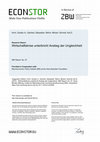
Research Papers in Economics, 2014
The report analyzes the impact of the global economic crisis on the dynamics of income inequality... more The report analyzes the impact of the global economic crisis on the dynamics of income inequality in Germany by disentangling changes in the various components of household market income. Two standard hypotheses are called into question: The first says that by the end of the 2000s the trend of rising income inequality in Germany had ended; the second claims that the trend reversal was mainly driven by the robust labour market development. By means of a decomposition of market income into the three income sources (1) household labour income from full-time work, (2) household labour income from atypical work, and (3) household capital income, we analyze the contribution of each component to overall market income inequality. It turns out that the slowdown in the rise of inequality at the end of the 2000s was mainly driven by changes in the distribution of capital income that nosedived with the outbreak of the crisis. Labour income dynamics even increased income inequality during this p...

Factor shares, personal income distribution and top incomes in Germany
Recent studies on income distribution in Germany reveal that the under-reporting of top incomes i... more Recent studies on income distribution in Germany reveal that the under-reporting of top incomes in survey data leads to substantial misjudgement in the development of inequality. The use of administrative tax data allows for a realistic consideration of top incomes and offers a more comprehensive coverage of capital income when measuring inequality. Moreover, these data more closely link inequality changes to macroeconomic developments in Germany. Taking this into amount, the alleged trend reversal in German inequality around 2005 appears to be a data-specific phenomenon which rests on the specific characteristics of survey data that primarily cover the lower tail of the income distribution. Moreover, such comprehensive evaluations suggest that inequality has more recently been increasing. A more valid assessment of inequality trends in Germany requires an improvement of the access to and the coupling of administrative micro data such as the German Taxpayer-Panel and the German Mikr...
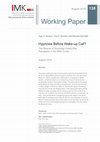
SSRN Electronic Journal, 2014
This paper qualifies the view of pronounced overpricing of sovereign bonds for the so-called GIIP... more This paper qualifies the view of pronounced overpricing of sovereign bonds for the so-called GIIPS countries during the financial crisis. We use annual data for 21 OECD countries from 1980 to 2012. As opposed to related studies, our data set allows us to contrast the pricing of macroeconomic fundamentals between three distinct phases: The period before the signing of the Maastricht treaty, the EMU-convergence era, and the financial crisis. In detail, we find: (i) Since the 1980s the role of public debt for the pricing of government bonds has changed twice: Firstly following the signing of the Maastricht treaty, and again with the wake-up call due to the onset of the financial crisis. (ii) Before the financial crisis EMU member countries had-de facto-been perceived as a homogenous group with regard to the role of public debt for sovereign risk pricing. (iii) With the reconsideration of countryspecific fundamentals the role of public debt has not only been revived but its impact upon bond yield spreads has become comparable to the time before the Maastricht treaty.
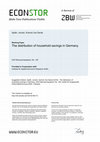
Jahrbücher für Nationalökonomie und Statistik, 2018
Against the ongoing assessment of the root causes of rising economic inequality in industrialized... more Against the ongoing assessment of the root causes of rising economic inequality in industrialized countries, analyses of the distribution of savings along the income and wealth distribution are of high interest. We analyze the concentration of household savings in Germany by estimating saving amounts, saving rates and shares in aggregate savings across income and wealth groups. Our calculations are based on the Sample Survey of Household Income and Expenditure (EVS), containing more than 40,000 households in Germany. We show that the concentration of savings is substantial: while the top income decile’s share in total savings reaches 60 percent, the lower half of the income distribution on average does not save at all. Across wealth groups the concentration of savings is somewhat less pronounced. We also look beyond the top income threshold underlying the EVS (18,000 euros of monthly net household income) and demonstrate that corrected saving rates for the top income groups are cons...
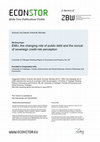
Using annual data for 21 OECD countries we provide evidence of remarkable mispricing of sovereign... more Using annual data for 21 OECD countries we provide evidence of remarkable mispricing of sovereign bonds for the so-called GIIPS countries before the start of the financial crisis. Our results also qualify the view of pronounced overpricing in the crisis. In detail, we find: (i) Since the 1980s the role of public debt for the pricing of government bonds has changed twice: First-time in the aftermath of the signing of the Maastricht treaty, and again with the wake-up call due to the onset of the financial crisis. (ii) Before the financial crisis EMU member countries had de facto been perceived as a homogenous group with regard to the role of public debt for sovereign risk pricing. (iii) With the reconsideration of country-specific fundamentals the role of public debt has not only been revived but its impact upon bond yield spreads has become comparable to the time before the Maastricht treaty.
Policy implications of the present consensus view of stabilization policy depend on specific assu... more Policy implications of the present consensus view of stabilization policy depend on specific assumptions with regard to the equilibrium level of production. Thereby, the interpretation of equilibrium output rests on a separation of supply-side and demandside adjustment to macroeconomic shocks promoting a dichotomy of short-term and long-term macrodynamics. In contrast to this, there are several channels that promote procyclical stimulus of aggregate demand and a changing factor utilization to the accumulation and efficiency of an economy's productive capacity. Medium-run macrodynamics call for a rather endogenous explanation of production capacity and challenge the uniqueness of long-term equilibria.
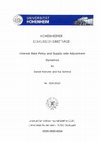
Diskussionspapiere Aus Dem Institut Fur Volkswirtschaftslehre Der Universitat Hohenheim, 2010
In contrast to the present consensus view of stabilization policy, theoretical and empirical rese... more In contrast to the present consensus view of stabilization policy, theoretical and empirical research strongly support the consideration of supply-side adjustment to pronounced variations of factor-utilization in order to trace a more realistic pattern of macroeconomic adjustment dynamics within simulation studies. Against this background, our paper seeks to illuminate the relevance of endogenous supply-side adjustment for monetary policy research. We modify a basic New Keynesian model by explicitly considering demand-side stimulus on the evolution of productive capacity and analyze stability, impulse response, and welfare issues if the central bank follows a simple monetary policy rule. Thereby, we control for the robustness of our policy implications by various states of output gap mismeasurement the central bank might be confronted with. We find that, in contrast to a basic New Keynesian Model, output gap stabilization plays a more prominent role when potential output is endogenous.
Imk Working Paper, Jun 1, 2013
We show that actively stabilizing economic activity plays a more prominent role in the conduct of... more We show that actively stabilizing economic activity plays a more prominent role in the conduct of monetary policy when potential output is subject to hysteresis. We augment a basic New Keynesian model by hysteresis in potential output and contrast simulation outcomes of this extended model to the standard model. We find that considering hysteresis allows for a more realistic propagation of macroeconomic shocks and persistent movements in output after monetary shocks. Our central policy implication of active output gap stabilization arises from stability analyses and welfare considerations.
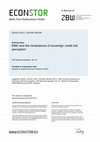
Iaw Discussion Papers, 2012
What is the role of fiscal variables for the assessment of sovereign credit risk? Has this role c... more What is the role of fiscal variables for the assessment of sovereign credit risk? Has this role changed over time? In the face of the financial crisis many OECD countries have experienced large increases of government debt relative to GDP. This has triggered a distinct response of financial markets reflected by a sharp rise of longterm interest on government bonds. We show that, in particular, within some member countries of the European Monetary Union the explanation of investors' recent reactions to these fiscal imbalances is twofold: first, it is the worsening of fiscal positions due to the financial crisis that has been taken into account. Second, and more striking, it is financial markets' reconsideration of the role of these fiscal fundamentals for the pricing of sovereign credit risk. We argue that, from a historical perspective, this recent re-evaluation of fiscal positions seems little surprising. It is rather the re-establishment of the temporarily interrupted pricing of fiscal imbalances as a central factor of sovereign credit risk than the aggravation of fiscal imbalances. In our study we provide crosscountry evidence for the impact of fiscal imbalances upon long-term interest rates. We use macroeconomic data from 1980 to 2012 and contrast a panel of 22 OECD countries with 11 EMU member countries and the so called GIIPS countries. This comparably long time span allows us to evaluate the changes in sovereign risk pricing that set in with the start of the EMU. In particular, we find that the relationship between the perceived default risk reflected by long-term interest rates and the public debt to GDP ratio as an indicator of fiscal sustainability is time regime as well as regional cluster specific. Our findings suggest that there is a strong connection of institutional aspects of EMU and the relationship between fiscal imbalances and changes in the pricing of sovereign credit risk.
In this paper we estimate the relevance of habits versus interpersonal comparisons for the consum... more In this paper we estimate the relevance of habits versus interpersonal comparisons for the consumption behavior of U.S. households. We exploit information from the recently released consumption expenditure data of the Panel Study of Income Dynamics (PSID) covering the time span from 1999 to 2009. We find that both habits, measured as lagged consumption, and envy motives, measured as reactions of consumption to consumption changes of households that are perceived to be richer, matter substantially. Hence, household consumption is not only determined by habit persistence but also by interpersonal comparisons. Most importantly, our estimations reveal that envy motives might play a much more prominent role for households' consumption choices than habits do.
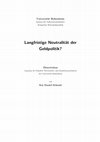
Eine solche kurzfristige Nichtneutralität wird im neukeynesianischen Modell auch als ein wichtige... more Eine solche kurzfristige Nichtneutralität wird im neukeynesianischen Modell auch als ein wichtiger Bestandteil der stabilitätspolitischen Strategie selbst angesehen (vgl. Abschnitt 2.3.2 und Abschnitt 2.4.3). Blinder (2004: 2) weist darauf hin, dass vor dem Hintergrund dieser makrotheoretischen Sichtweise die primäre Aufgabe der Stabilitätspolitik vor allem in der Verteidigung einer Zielinflationsrate gesehen wird, wobei sich die als kurzfristig angenommenen, geldpolitischen Nachfrageimpulse nicht auf die Entwicklung der Produktionskapazität einerÖkonomie auswirken. " The prevailing view today is that stabilization policy it is about filling in troughs and shaving off peaks, that is, reducing the variance of output around a mean trend that is itself unaffected by monetary or fiscal policy." 4 Der in dieser Arbeit mehrfach gebrauchte Begriff eines " konjunkturexogenen" Produktionspotenzials drückt die verbreitete Annahme aus, dass die Entwicklung der Produktionsfaktoren weitgehend unabhängig von Variationen der Güternachfrage und den damit verbundenen Veränderungen der Faktorauslastung verläuft. Konjunkturelle Schwankungen, die durch technologische Schocks verursacht werden, wirken sich dagegen auch auf das Produktionspotenzial derÖkonomie aus.
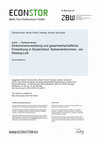
Wirtschaftsdienst, 2015
Die Dokumente auf EconStor dürfen zu eigenen wissenschaftlichen Zwecken und zum Privatgebrauch ge... more Die Dokumente auf EconStor dürfen zu eigenen wissenschaftlichen Zwecken und zum Privatgebrauch gespeichert und kopiert werden. Sie dürfen die Dokumente nicht für öffentliche oder kommerzielle Zwecke vervielfältigen, öffentlich ausstellen, öffentlich zugänglich machen, vertreiben oder anderweitig nutzen. Sofern die Verfasser die Dokumente unter Open-Content-Lizenzen (insbesondere CC-Lizenzen) zur Verfügung gestellt haben sollten, gelten abweichend von diesen Nutzungsbedingungen die in der dort genannten Lizenz gewährten Nutzungsrechte. Terms of use: Documents in EconStor may be saved and copied for your personal and scholarly purposes. You are not to copy documents for public or commercial purposes, to exhibit the documents publicly, to make them publicly available on the internet, or to distribute or otherwise use the documents in public. If the documents have been made available under an Open Content Licence (especially Creative Commons Licences), you may exercise further usage rights as specified in the indicated licence.









Uploads
Papers by Kai Daniel Schmid